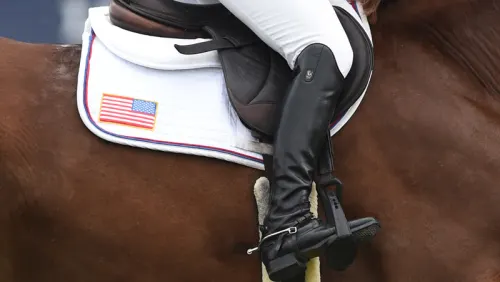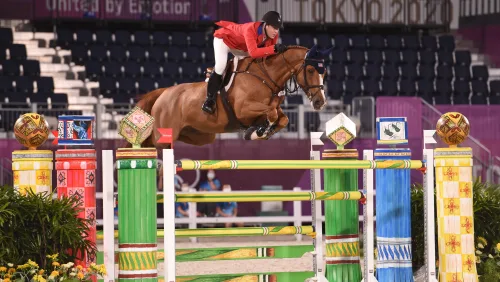When medals are decided by fractions of a second, it makes for incredibly exciting sport, but the format could use some tweaking, too.
Looking back at the show jumping of the Alltech FEI World Equestrian Games in Normandy, it was incredibly exciting sport, I think, because the competition was so close.
The German team was extremely strong, with four of their best riders on four of the best horses on their best form. After Day 1, I thought they were really on it, and their horses looked solid. But that wasn’t enough for a team medal. It was so close. Medals were decided by 1/10 of a second.
It was so exciting to watch; if Ludger Beerbaum had ridden a clear round, Germany would have won gold. He had one down, and they were out of the medals completely. If the U.S. team had had one less rail, they would have won gold instead of bronze.
That just shows how close the sport has gotten. The teams that I thought would be in the medals [in my predictions column in the Chronicle’s World Equestrian Games Preview Issue] were right up there, but it’s amazing how close the scores were between the medals and being just out of the medals.
I don’t think it was a great surprise that the Dutch won. They’re very strong riders and a strong team, but in this day and age, any one of the top nations and riders can win. It’s about little, tiny things that make a difference. The U.S. riders’ times were 1/10 of a second faster on Day 1 than the Germans’, and that made the difference between a bronze medal and no medal in the end.
I think the Dutch have great horses and great riders, but a lot of nations have those. One of their strongest qualities is that they have an incredible team spirit. They know each other really well. The country is quite small. There’s not a lot of elbowing each other.
They like each other and fight as a team perhaps better than any other nation. Since their number of top riders is so small, their system for team selection doesn’t require one rider to edge out the other one. So they’re strong when it comes to team competition.
Patience Is A Virtue
And then once Jeroen Dubbeldam made it into the top four, I had my money on him. I know Jeroen quite well and respect him tremendously as a rider.
He was Olympic champion [at the 2000 Sydney Games]. He has an amazing feel for horses. He’s a very patient rider who never overfaces a horse. He built up Zenith from the bottom. That horse didn’t look particularly extraordinary in any sense in the beginning. But he’s the kind of rider who gives the horse time, and over the years he built the horse up to where it is. He’s ridden all different kinds of horses and consistently brought along many horses to the top level.
He’s been successful on horses that other people gave up on or didn’t think much of. His ability to communicate with a horse has been obvious over the years. I wouldn’t say he’s the one who wins every class. There are riders who go to every show and go for first place regardless; that’s not Jeroen Dubbeldam.
His personality makes him so patient. He waits until the horse is over-qualified for what he does before he puts it in a situation where it might fail. Between that personality and his extreme talent and feeling for the horse as a rider, I thought he could take it all.
ADVERTISEMENT
He had the most difficult horse, and that was clear in the final four. Beezie Madden rode beautifully all weekend to make the final four. She’s been there before. Patrice Delaveau lives 40 kilometers from Caen, and he has an incredible string of horses. He has a great sponsor, and they did an amazing job. He had a tremendous amount of pressure to perform, perhaps more than anyone, and he did it. For him, the time fault [that dropped him to silver] was unfortunate.
It is so difficult now and so close. McLain Ward had a great week and two clear rounds on the last day, and he still didn’t make the final four. Years ago, at the 2006 FEI World Equestrian Games in Aachen (Germany), Edwina Alexander was 22nd in the standings, and she jumped a double clear on the last day and ended up in the final four.
That just gives you a little bit of an example of the difference of how the courses were set in Normandy. There were great horses and riders there, but there were more clear rounds on the last individual day, so it was harder to move up.
It was a little bit of a different World Championships, but it was fun to watch. Jeroen gave a demonstration of great riding on that day. He was absolutely a phenomenon to watch.
Too Many Qualified
The course designer, Frédéric Cottier, did an amazing job. The first leg looked really light, but he got the best riders at the top. He had to set for 150 riders of very mixed abilities, which was a difficult job. I can’t say enough positive about that course.
One comment from most riders is that there were way too many riders. It wasn’t exciting to watch 150 riders, many of whom quite clearly did not belong at the World Equestrian Games, in one day. The thought from everyone was that the standards to qualify were way too lenient.
When we walked the first course, the course seemed quite light. I rode in two World Championships previous to this one, and the course on the first day was not even close to the heights or spreads that we had in Aachen or in Kentucky. The course designer did a brilliant job to still get the best riders at the top, which was really hard to do over a course like that.
But it was a course that was meant to be that light, because he didn’t want to kill off the riders who weren’t really meant to be there, to be quite frank about it. He did a masterful job.
As the week went on, every day the courses were a little bit more difficult. He got the best horses and riders to the top. It was difficult to go clear, but we all thought it was not as hard as the last two championships. It’s not an easy thing to do, to build for this competition, and he did an amazing job.
I have to say that this year in Normandy was a great advertisement for the format of the final four because it went so well. No horse had a bad experience like Shutterfly did in Aachen in 2006.
But in general, is it the best format for the individual medals? I don’t know.
It’s a really tough format. Those horses have to jump so much in one week. It’s like no other championship. It’s so hard, starting with the warm-up and then the speed competition the first day, then the two Nations Cup rounds, and then two more rounds of the individual, and then four more rounds on the last day.
ADVERTISEMENT
It’s incredible what those horses that go all the way through the week have to jump. It was really fun to watch; it makes great spectator sport. But is it the best test of a horse and rider? That’s debatable. In Aachen, in 2006, it was tough on my horse.
I don’t know that it’s the best test of a rider, though Jeroen Dubbeldam’s fantastic display of riding this time could argue that it is. Personally, I think the horse and rider is a combination of the two, and the best horse/rider combination is, for me, more important. It’s about managing your horse all year long, not overusing him, not overfacing him, caring for his health, and making sure he’s in the best form on the day at the championships.
If I were to be asked, I’d say I’d like to see the champion in the end be the champion with his own horse, not just the rider on his own. That’s my opinion.
The Horses Were Happy
The venue for jumping was fantastic. The stadium itself was great, and the facilities for the horses were perfect—stabling, warm-up, footing.
Interestingly, there were mixed reviews on the championships as a whole. There were a lot of organizational details that weren’t perfect. But in general, the sport itself was very exciting.
On the negative side, I think the whole World Equestrian Games were divided up over the entire city of Caen, and it was very difficult to see other disciplines. The stadium for the show jumping was a good 15- or 20-minute walk from the village. They closed the stadium mid-way through the day—they closed down and kicked everyone out—and people had to walk to the village to get a hot dog. That seems like a spectator’s nightmare.
However, for horse and rider it was fantastic.
I think for the spectators there in the stadium, it was almost impossible to follow how close the team competition was unless they were using their phones to look up the results on the Internet. They didn’t really display the results in the stadium in a way that showed how tight it was.
We knew how close it was, but I talked to some spectators who were professional horse people who didn’t realize how close it was for the medals. They didn’t know the breakdown of all the scores. The spectators could really use a better leaderboard in the stadium to help them keep up with the scores.
Meredith Michaels-Beerbaum grew up in the Los Angeles area and trained with the likes of Karen Healey and George Morris in her junior days. In 1991, she moved to Germany to work for Paul Schockemöhle and then married German rider Markus Beerbaum. They now run a successful stable in Thedinghausen, Germany.
Michaels-Beerbaum has won the FEI World Cup Final three times and was the first woman to represent Germany in a major championship. She has represented Germany at two Olympic Games and helped Germany win team gold at the 2010 Alltech FEI World Equestrian Games. She also earned team and individual bronze at the 2006 World Games.















